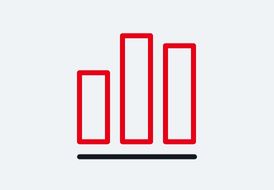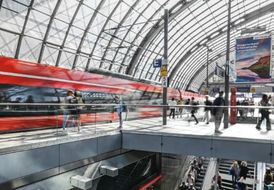Development in the year under review
- Revenue and performance development driven mainly by recovery effects – pre-Covid-19 levels not yet reached.
- Transformation program leads to cost reductions and improved economic management.
- 2022 strongly influenced by a strategic decision to withdraw from countries that are not part of the core business, including the sale of activities in Sweden and Portugal.
DB Arriva | 2022 | 2021 | Change | 2019 | |
absolute | % | ||||
Punctuality (rail) (United Kingdom, Denmark, Sweden, the Netherlands, Poland and the Czech Republic) 1) (%) | 90.2 | 93.5 | –3.3 | – | 87.6 |
Customer satisfaction for bus and rail in the United Kingdom (SI) | 73 | 77 | –4 | – | 78 |
Passengers (bus and rail) (millions) | 1,546 | 1,308 | +238 | +18.2 | 2,214 |
Volume sold (rail) (million pkm) | 6,167 | 4,663 | +1,504 | +32.3 | 12,617 |
Volume produced (bus) (million bus km) | 884.5 | 947.6 | –63.1 | –6.7 | 1,065 |
Volume produced (rail) (million train-path km) | 100.0 | 109.2 | –9.2 | –8.4 | 168.9 |
Total revenues (€ million) | 4,214 | 4,069 | +145 | +3.6 | 5,410 |
External revenues (€ million) | 4,212 | 4,067 | +145 | +3.6 | 5,405 |
EBITDA adjusted (€ million) | 411 | 359 | +52 | +14.5 | 752 |
EBIT adjusted (€ million) | 12 | –73 | +85 | – | 289 |
Gross capital expenditures (€ million) | 255 | 267 | –12 | –4.5 | 718 |
Employees as of Dec 31 (FTE) | 38,059 | 43,189 | –5,130 | –11.9 | 52,331 |
Annual average employees (FTE) | 40,688 | 44,187 | –3,499 | –7.9 | 52,855 |
Employee satisfaction (SI) | 3.7 | – | – | – | – |
Share of women as of Dec 31 (%) | 14.6 | 13.6 | +1.0 | – | 14.9 |
Specific greenhouse gas emissions (rail) compared to 2006 (based on rail car units) (%) | –16.0 | –17.3 | +1.3 | – | –9.7 |
Specific greenhouse gas emissions (bus) compared to 2006 (based on bus km) (%) | –28.0 | –14.9 | –13.1 | – | –10.1 |
1) From July 2022, excluding the sold activities in Sweden.
The development in 2022 was influenced by two key factors:
- the recovery process from the effects of the Covid-19 pandemic and
- the sale and effects of preparing to sell activities in non-core countries (in particular in Sweden, with an effect on revenues of € –171 million).
Punctuality in rail passenger transport decreased, mainly as a result of extreme weather events, infrastructure failures and speed restrictions, as well as the impact of industrial action across United Kingdom operations.
Customer satisfaction for UK Trains remained unchanged. Reduced customer satisfaction in the UK Bus regions was a result of strikes in the context of collective bargaining negotiations and the ongoing impact of driver shortages which has affected service levels and punctuality.
The performance trend has recovered strongly, but the pre-Covid-19 level has not yet been reached again. Overall, the recovery effects led to an increase in passenger numbers (bus and rail) and in rail transport volume produced. Dampening effects resulted from sales of non-core activities.
Economic development has improved significantly, mainly due to the ongoing recovery process, but remains strained.The ongoing transformation program which has put a framework in place to actively manage the business and its portfolio, specific and focused capital expenditures and the divesting of markets that are less attractive and not core to the growth strategy (non-core activities) had an additional positive effect.
Overall, income development was positive:
- Revenues: Increase mainly due to the Covid-19 recovery effects in all lines of business as well as higher concession fees due to general price adjustments. The sale of non-core activities, particularly in Sweden, had a dampening effect.
- Other operating income: Significant decline (–15.8%/€ –68 million) due to lower government Covid-19 support measures as a result of the recovery in demand.
The expense side remained mostly unchanged. Positive divestment effects were almost fully compensated by higher fuel prices, performance-related increased costs and negative exchange rate effects:
- Personnel expenses: Noticeable decline (–6.0%/€ –129 million), mainly due to sale of activities in Sweden, business review in Denmark and the omission of pension-related one-off effects in the previous year.
- Depreciation: Decline (–7.6%/€ –33 million) mainly due to divestment effects as well as due to a change in accounting for leased assets at Chiltern Railways. Partially compensated by effects from changes in the method of depreciation for buses.
- Other operating expenses: Decrease (–1.1%/€ –6 million), mainly due to the omission of provision-related on-off effects in the previous year. Effects from reclassification of management fees for the centralization of departments at UK Bus (which were offset in other operating income), recovery effects as well as negative exchange rate effects had a partly offsetting effect.
The significant increase in the cost of materials almost fully compensate the development:
- Cost of materials: The significant increase (+11.6%/€ +167 million) is mainly due to higher energy, maintenance and rail replacement expenses, as well as exchange rate effects. The divestment of non-core activities had a dampening effect.
Capital expenditures declined as a result of the absence of high capital expenditures in the Netherlands and Slovakia from the previous year. The sale of non-core activities also had a reducing effect.
The number of employees decreased in all lines of business, above all in Mainland Europe due to divestment effects. Corporate center restructuring commenced in 2022 resulting in headcount reductions.
Compared to 2020, employee satisfaction remained stable.
The share of women increased slightly.
Specific CO₂ emissions compared to the reference year 2006 in rail transport have slightly declined, mainly as a result of the sale of electrified transports in Sweden. However, the level of bus traffic has improved significantly, mainly as a result of the decommissioning of old, inefficient buses.
- Recovery continuing, but the effects of the Covid-19 pandemic are still noticeable.
- Lower government support measures balanced out the recovery effects to some extent.
- Additional burdens due to strikes, driver shortages, inflationary pressure, wage effects and higher fuel prices.
UK Bus line of business | 2022 | 2021 | Change | 2019 | |
absolute | % | ||||
Passengers (million) | 539.0 | 402.3 | +136.7 | +34.0 | 716.5 |
Volume produced (million bus km) | 282.6 | 304.9 | –22.3 | –7.3 | 345.9 |
Total revenues (€ million) | 943 | 861 | +82 | +9.5 | 1,076 |
External revenues (€ million) | 943 | 861 | +82 | +9.5 | 1,074 |
EBITDA adjusted (€ million) | 88 | 48 | +40 | +83.3 | 134 |
EBIT adjusted (€ million) | –29 | –48 | +19 | –39.6 | 44 |
Gross capital expenditures (€ million) | 62 | 50 | +12 | +24.0 | 64 |
Employees as of Dec 31 (FTE) | 13,161 | 13,398 | –237 | –1.8 | 15,130 |
UK Bus recorded an increase in passenger numbers following the end of Covid-19-related restrictions, such as shutdowns in early 2021.
Schedules have been adjusted to current service levels, reducing regional transport services.
The economic development has improved. Revenue growth and lower expenses outpaced the negative impact of declining Covid-19 government support and higher prices on the cost side. Operating profit figures improved.
Overall, income development was positive:
- Revenues: Development improved, mainly due to the recovery in demand as well as positive exchange rate effects.
- Other operating income: Significant decrease, mainly as a result of lower Covid-19 support measures due to the recovery in demand. Positive exchange rate effects, among others, had a dampening effect.
On the expense side, it was mainly lower personnel expenses that led to a decrease:
- Personnel expenses: Decrease driven by the omission of previous years one-off effects from the closure of pension plans and effects from a lower headcount. Negative exchange rate effects, among others, had a dampening effect.
- Cost of materials: Decrease driven by lower maintenance costs, that were partly offset by higher energy prices and negative exchange rate effects.
The decrease in expenses was partially compensated by the increase in depreciation:
- Depreciation: Increased due to changes in bus depreciation accounting policy.
- Other operating expenses: Increase due to the reclassification of management fees for the centralization of departments (offset in other operating income) and negative exchange rate effects.
Capital expenditures increased significantly, mainly due to a project for a new depot and the increase in capital expenditures in health and safety as well as the revaluation of assets (IFRS 16).
The number of employees decreased noticeably as a result of the reduced volume produced and ongoing challenges related to sickness and operations.
- Sustained recovery in revenues from fares after Covid-19, partly offset by the effects of the rise in the cost of living.
- Lower government support measures largely offset by Covid-19 recovery effects.
- Additional expenses due to higher energy prices due to the effects of the war in Ukraine.
- Development influenced by structural changes due to the new contract for Chiltern Railways.
UK Trains line of business | 2022 | 2021 | Change | 2019 | |
absolute | % | ||||
Passengers (million) | 173.1 | 118.6 | +54.5 | +46.0 | 354.8 |
Volume sold (million pkm) | 4,658 | 2,863 | +1,795 | +62.7 | 10,264 |
Volume produced (million train-path km) | 49.4 | 48.0 | +1.4 | +2.9 | 115.8 |
Total revenues (€ million) | 1,227 | 1,141 | +86 | +7.5 | 2,190 |
External revenues (€ million) | 1,189 | 1,107 | +82 | +7.4 | 2,137 |
EBITDA adjusted (€ million) | 46 | 34 | +12 | +35.3 | 220 |
EBIT adjusted (€ million) | 27 | 0 | +27 | – | 80 |
Gross capital expenditures (€ million) | 11 | 6 | +5 | +83.3 | 277 |
Employees as of Dec 31 (FTE) | 4,747 | 4,844 | –97 | –2.0 | 11,215 |
The performance development at UK Trains was mainly driven by the effects of the Covid-19 recovery process.
The economic development has improved. Positive effects seen from the ongoing recovery process were only partially offset by lower government support and additional expenses. As a result, operating profit figures rose.
Income development was significantly better:
- Revenues: Increase due to higher revenues from fares driven by higher volumes as well as positive exchange rate effects. Lower government Covid-19 support measures partially offset this.
- Other operating income: Increase mainly due to negotiated commercial settlements and increased income in relation to rail replacement services.
On the expenses side, price and volume-related higher expenses as well as exchange rate effects led to increased expenses:
- Cost of materials: Significant growth, mainly due to increased spot price and volume related fuel costs as well as negative exchange rate effects.
- Personnel expenses: Remained unchanged. Negative exchange rate effects were mostly offset by a lower number of employees.
- Other operating expenses: Also remained unchanged.
The decrease in depreciation partially compensated for this:
- Depreciation: Significant decrease due to a change in accounting for leased assets at Chiltern Railways.
Capital expenditures rose, primarily due to significantly higher investment grants for rolling stock capex at Chiltern Railways regarding the new National Rail Contract.
The number of employees fell slightly due to voluntary severance scheme and on-board catering attrition.
- Continued recovery from the effects of Covid-19 (particularly in the Netherlands, the Czech Republic, Italy and Croatia).
- The sale of activities in Sweden and Portugal and preparation for the sale of activities in Denmark, Serbia and Poland have a dampening effect.
- Additional burdens due to higher energy prices and further significant cost increases.
Mainland Europe line of business | 2022 | 2021 | Change | 2019 | |
absolute | % | ||||
Passengers (bus) (million) | 763.9 | 696.0 | +67.9 | +9.8 | 1,018 |
Passengers (rail) (million) | 70.2 | 91.2 | –21.0 | –23.0 | 125.4 |
Volume sold (rail) (million pkm) | 1,509 | 1,800 | –291 | –16.2 | 2,353 |
Volume produced (bus) (million bus km) | 601.8 | 642.7 | –40.9 | –6.4 | 719.5 |
Volume produced (rail) (million train-path km) | 50.6 | 61.2 | –10.6 | –17.3 | 53.2 |
Total revenues (€ million) | 2,259 | 2,258 | +1 | – | 2,321 |
External revenues (€ million) | 2,079 | 2,098 | –19 | –0.9 | 2,182 |
EBITDA adjusted (€ million) | 324 | 340 | –16 | –4.7 | 402 |
EBIT adjusted (€ million) | 65 | 44 | +21 | +47.7 | 174 |
Gross capital expenditures (€ million) | 181 | 210 | –29 | –13.8 | 377 |
Employees as of Dec 31 (FTE) | 19,812 | 24,585 | –4,773 | –19.4 | 25,572 |
In 2022, activities in some countries that are not part of the core business were sold (Sweden and Portugal) or prepared for sale (Denmark, Serbia and the Polish bus business). This results in limited comparability with previous years.
Performance development was differentiated. Positive effects, driven by a recovery in demand, were offset by the divestment effects:
- Rail transport: The decline in performance is due to the sale of activities in Sweden. Recovery effects in all countries had a positive effect.
- Bus transport: The number of passengers increased, especially as a result of the recovery from Covid-19, partly compensated by sales of non-core activities. Volume produced and volume sold decreased due to the effects of sales of non-core activities.
The economic development was mainly driven by divestments, effective portfolio management and the Covid-19 recovery process. EBITDA adjusted fell while EBIT adjusted rose significantly:
- Revenues: Remained mainly unchanged. Recovery in demand and higher concession fees due to contractual indexation in the Netherlands, Slovakia and the Czech Republic were offset by the effects of sales of non-core activities.
- Other operating income: Significant decrease mainly driven by a reduction in government Covid-19 support in the Netherlands and sales of non-core activities. Higher government support in Italy has a dampening effect.
The expense side was strongly influenced by declines as a result of sales of non-core activities which were partly offset by higher energy costs as well as recovery effects:
- Personnel expenses: Sharp decline. Effects from a decline in the number of employees (mainly due to divestures) and positive exchange rate effects were partly offset by higher costs due to the shortage of drivers.
- Depreciation: Decline mainly due to sales of non-core activities.
- Other operating expenses: Decrease mainly due to the omission of provision related one-off effects of previous year. Recovery-related higher expenses in the Netherlands has a dampening effect.
The significant increase in the cost of materials had a dampening effect:
- Cost of materials: This increase is mainly due to higher fuel costs and higher expenses for purchased services as a result of the recovery from Covid-19. The sales of non-core activities and the transformation program resulted in cost-reducing effects.
The decline in capital expenditures resulted from sales of non-core activities and the largely completed capital expenditure projects in the previous year.
The number of employees fell significantly due to sales of non-core activities and the review of the business in Denmark.


